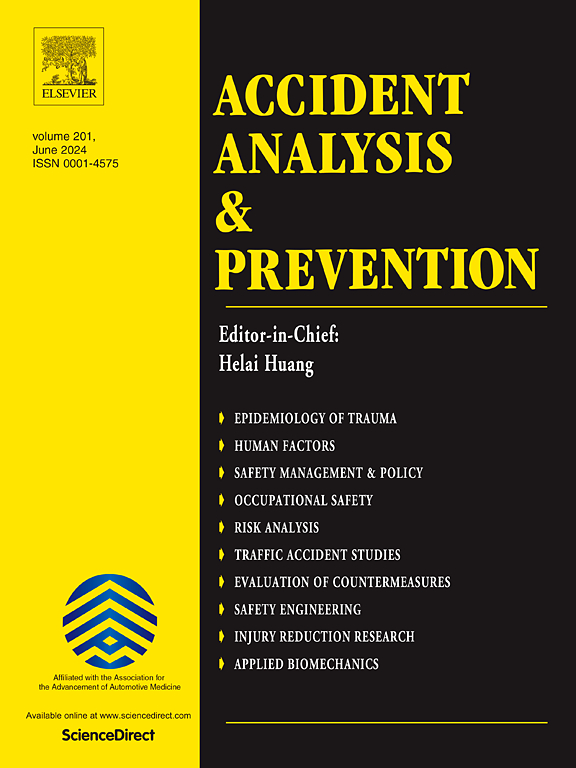互联车辆信息能否降低雾天高速公路上的超视距碰撞风险?基于极值理论的研究
IF 5.7
1区 工程技术
Q1 ERGONOMICS
引用次数: 0
摘要
智能网联汽车技术可以为驾驶员提供网联车辆信息,提高交通安全。然而,目前尚不清楚在雾蒙蒙的高速公路上,CVI对安全的影响。因此,本文引入极值理论(EVT)来评估和量化这种影响。具体而言,本文首先采用驾驶仿真技术搭建互联环境实验平台。设计了典型的雾蒙蒙高速公路超视距场景,开展了驾驶仿真实验,收集了传统环境(无CVI)和联网环境(有CVI)下的驾驶行为数据。利用该数据,利用EVT的峰值超过阈值法,分别建立了碰撞时间(TTC)、修正碰撞时间(MTTC)、入侵后时间(PET)和避免碰撞减速率(DRAC) 4个指标的广义Pareto分布拟合模型,并对模型进行了比较和选择。然后选择最优模型进行风险评估和影响分析,包括碰撞概率和碰撞损伤维度。结果表明,基于dras的EVT模型具有较好的数据拟合性能和较高的可靠性。此外,CVI可有效降低雾天高速公路超视距事件的碰撞风险,不同驾驶群体的碰撞风险和CVI应用的有效性存在差异。本文的研究进一步扩展了EVT,也有助于更好地理解CVI的作用和影响机制。本文章由计算机程序翻译,如有差异,请以英文原文为准。
Does connected vehicle information reduce beyond-visual-range crash risk in foggy freeway conditions? A study based on extreme value theory
Intelligent connected vehicle technology can provide drivers with connected vehicle information (CVI) to enhance traffic safety. However, the impact of CVI on safety in the case of foggy freeway beyond-visual-range conditions is currently unclear. As such, this paper introduces extreme value theory (EVT) to assess and quantify this impact. Specifically, this paper first adopted driving simulation technology to build a connected environment experimental platform. A typical foggy freeway beyond-visual-range scenario was developed, and driving simulation experiments were carried out to collect driving behavior data in both traditional environments (without CVI) and connected environments (with CVI). With this data, the peak over threshold method of EVT was used to establish generalized Pareto distribution fitting models for the four indicators of time to collision (TTC), modified time to collision (MTTC), post-encroachment time (PET), and deceleration rate to avoid a crash (DRAC), respectively, and model comparisons and selections were performed. The optimal models were then chosen for risk assessment and impact analysis, which includes both crash probability and crash damage dimensions. The results show that the DRAC-based EVT models have better data-fitting performance and higher reliability. Additionally, CVI is effective in reducing the crash risk of beyond-visual-range events on foggy freeways, and there is diversity in crash risk and the effectiveness of CVI application between different driving groups. The study in this paper further extends the EVT and also helps to better understand the action and influence mechanisms of CVI.
求助全文
通过发布文献求助,成功后即可免费获取论文全文。
去求助
来源期刊

Accident; analysis and prevention
Multiple-
CiteScore
11.90
自引率
16.90%
发文量
264
审稿时长
48 days
期刊介绍:
Accident Analysis & Prevention provides wide coverage of the general areas relating to accidental injury and damage, including the pre-injury and immediate post-injury phases. Published papers deal with medical, legal, economic, educational, behavioral, theoretical or empirical aspects of transportation accidents, as well as with accidents at other sites. Selected topics within the scope of the Journal may include: studies of human, environmental and vehicular factors influencing the occurrence, type and severity of accidents and injury; the design, implementation and evaluation of countermeasures; biomechanics of impact and human tolerance limits to injury; modelling and statistical analysis of accident data; policy, planning and decision-making in safety.
 求助内容:
求助内容: 应助结果提醒方式:
应助结果提醒方式:


